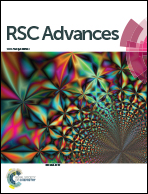Efficient phosphorescent polymer light-emitting devices using a conjugated starburst macromolecule as a cathode interlayer
Abstract
We present the results of a systematic study of a conjugated starburst macromolecule TrOH cathode interlayer produced by solution-processing for the fabrication of highly efficient multilayered phosphorescent polymer light-emitting devices (PhPLEDs). It was found that the performance of the PhPLEDs was strongly dependent on the solvent composition of the TrOH coatings. The devices with the interlayer deposited from the mixed-solvent of water and ethanol showed much better device performance than that of the device with ethanol as solvent. From the impedance spectra of the devices and UV-vis absorption spectra of the emission layers (EMLs) treated by ethanol or mixed-solvent, the variation in device performance is mainly attributed to washing out the electron transport material in the EML due to the rinse effect. The erosion of the EML could be greatly suppressed by adding an appropriate amount of water into ethanol. The optimized green device with a maximum luminous efficiency of 23.4 cd A−1 and an external quantum efficiency of 6.7% was obtained when the ethanol : water ratio approached 7 : 3 (v/v). The peak efficiency of 14.6 cd A−1 was also achieved in a single emissive layer white PhPLED with a TrOH interlayer. In order to further understand the effect of the TrOH interlayer deposited from different solutions on the device performance, atomic force microscopy and contact angles were used to investigate the surface properties of the TrOH interlayer. The results indicate that the interfacial morphology is mainly controlled by the wetting characteristics of the EML and TrOH solution. The inferior device performance can be ascribed to the discontinuous TrOH film when the amount of water in TrOH solution is above 40%, which leads to the subdued electron injection from cathode into the EML.


 Please wait while we load your content...
Please wait while we load your content...